双向认证,顾名思义,客户端和服务器端都需要验证对方的身份,在建立HTTPS连接的过程中,握手的流程比单向认证多了几步。单向认证的过程,客户端从服务器端下载服务器端公钥证书进行验证,然后建立安全通信通道。双向通信流程,客户端除了需要从服务器端下载服务器的公钥证书进行验证外,还需要把客户端的公钥证书上传到服务器端给服务器端进行验证,等双方都认证通过了,才开始建立安全通信通道进行数据传输。
1. 原理
1.1 单向认证流程
单向认证流程中,服务器端保存着公钥证书和私钥两个文件,整个握手过程如下:
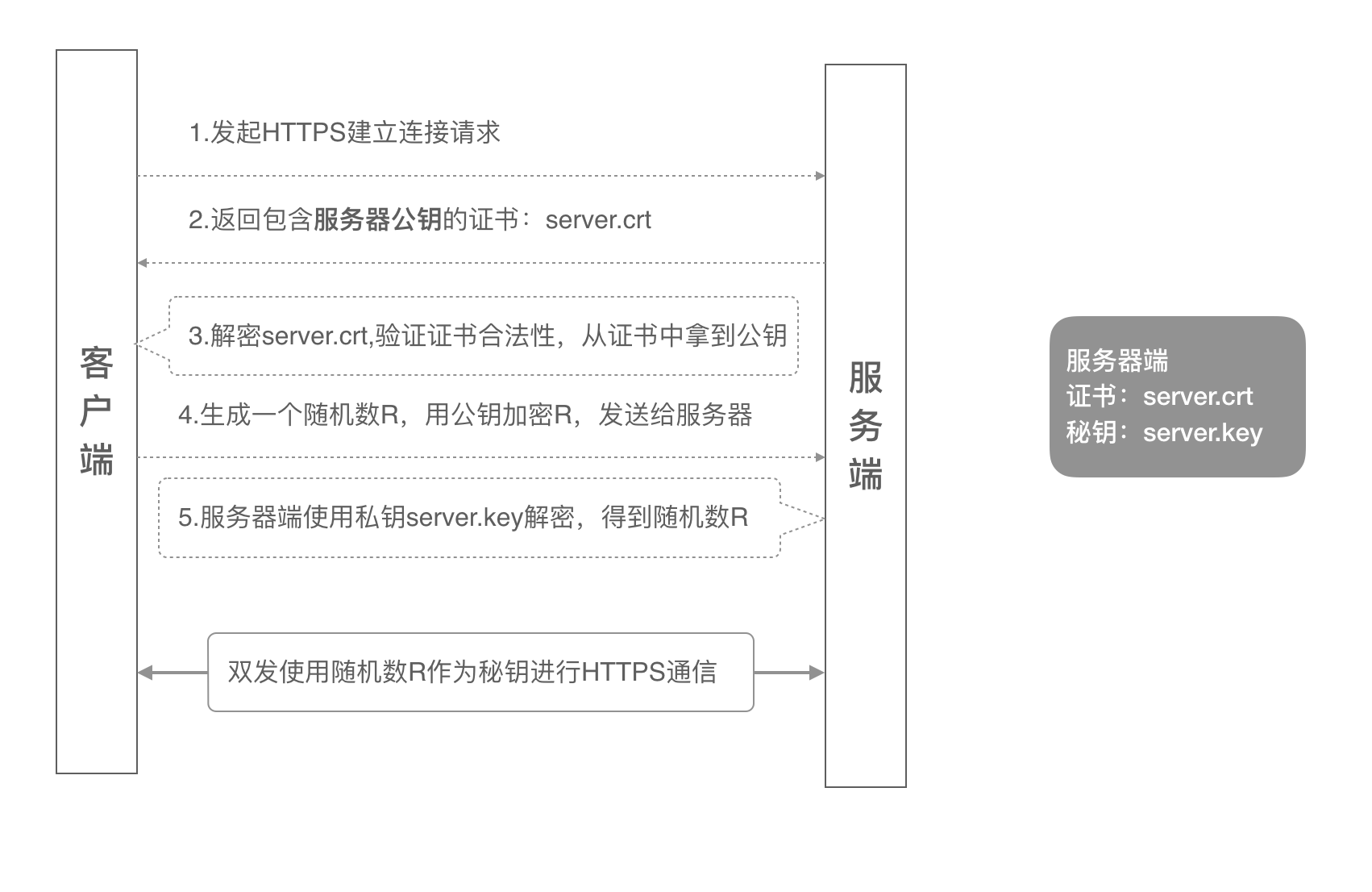
-
客户端发起建立HTTPS连接请求,将SSL协议版本的信息发送给服务器端;
-
服务器端将本机的公钥证书(server.crt)发送给客户端;
-
客户端读取公钥证书(server.crt),取出了服务端公钥;
-
客户端生成一个随机数(密钥R),用刚才得到的服务器公钥去加密这个随机数形成密文,发送给服务端;
-
服务端用自己的私钥(server.key)去解密这个密文,得到了密钥R
-
服务端和客户端在后续通讯过程中就使用这个密钥R进行通信了。
1.2 双向认证流程
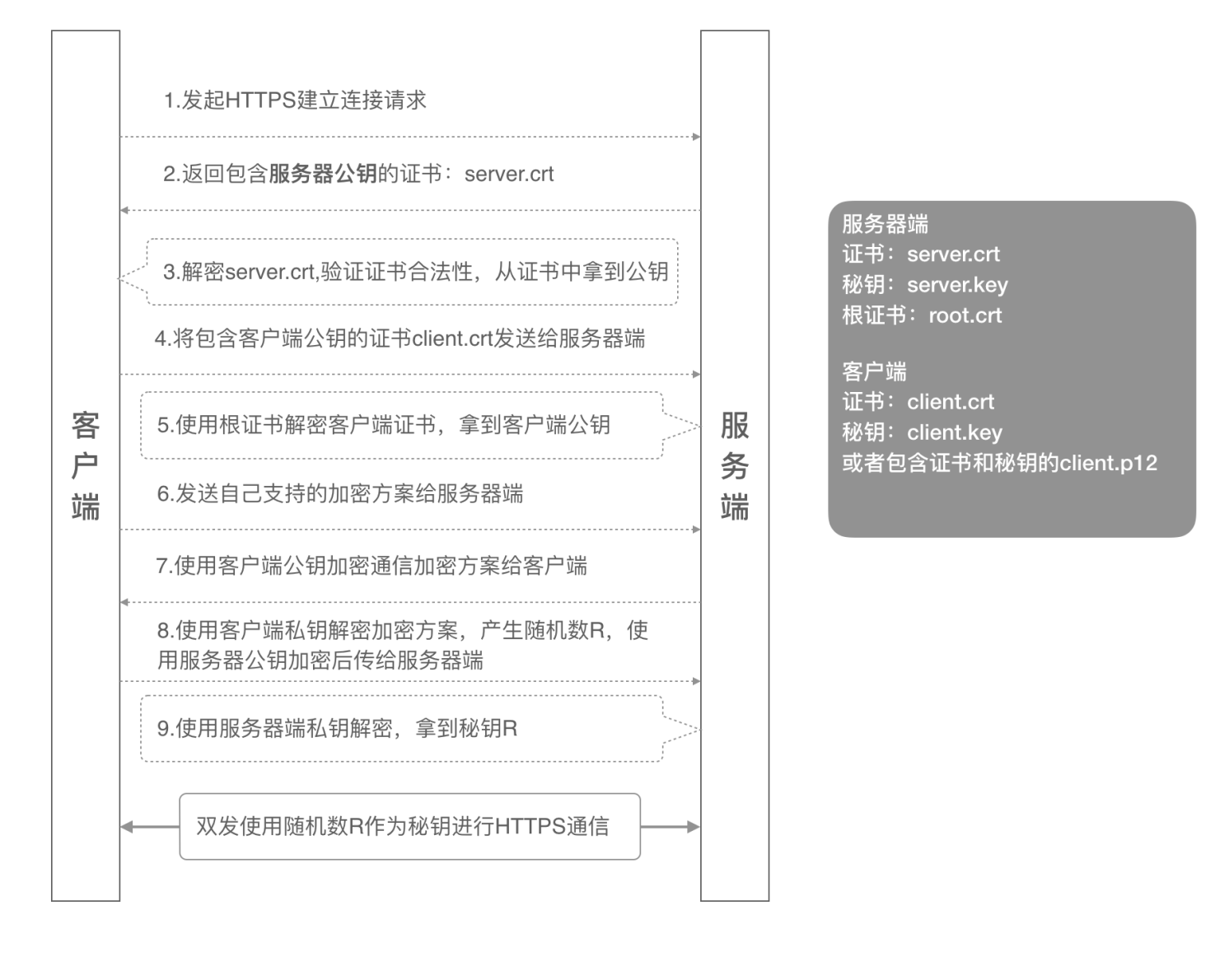
-
客户端发起建立HTTPS连接请求,将SSL协议版本的信息发送给服务端;
-
服务器端将本机的公钥证书(server.crt)发送给客户端;
-
客户端读取公钥证书(server.crt),取出了服务端公钥;
-
客户端将客户端公钥证书(client.crt)发送给服务器端;
-
服务器端使用根证书(root.crt)解密客户端公钥证书,拿到客户端公钥;
-
客户端发送自己支持的加密方案给服务器端;
-
服务器端根据自己和客户端的能力,选择一个双方都能接受的加密方案,使用客户端的公钥加密后发送给客户端;
-
客户端使用自己的私钥解密加密方案,生成一个随机数R,使用服务器公钥加密后传给服务器端;
-
服务端用自己的私钥去解密这个密文,得到了密钥R
-
服务端和客户端在后续通讯过程中就使用这个密钥R进行通信了。
2. 证书准备
从上一章内容中,我们可以总结出来,整个双向认证的流程需要六个证书文件:
-
服务器端公钥证书:server.crt
-
服务器端私钥文件:server.key
-
根证书:root.crt
-
客户端公钥证书:client.crt
-
客户端私钥文件:client.key
-
客户端集成证书(包括公钥和私钥,用于浏览器访问场景):client.p12
所有的这些证书,我们都可以向证书机构去申请签发,一般需要收取一定的证书签发费用,此时我们需要选择大型的证书机构去购买。如果只是企业内部使用,不是给公众使用,也可以自行颁发自签名证书,具体的颁发办法请参见本文第四章。
3.在API网关配置HTTPS双向认证
在准备好上一章提到的六个证书文件后,就可以在API网关配置HTTPS的双向认证能力了,在配置之前,我们首先需要在API网关上拥有一个分组,并且在分组下绑定好了您的域名。本节介绍下将域名对应的服务器证书、根证书绑定到API网关来实现HTTPS双向认证的能力。
步骤1. 进入分组详情页面,找到要绑定的域名,点击域名对应的“选择证书”链接;

步骤2. 进入选择证书子页面,选择“手动添加证书”链接;
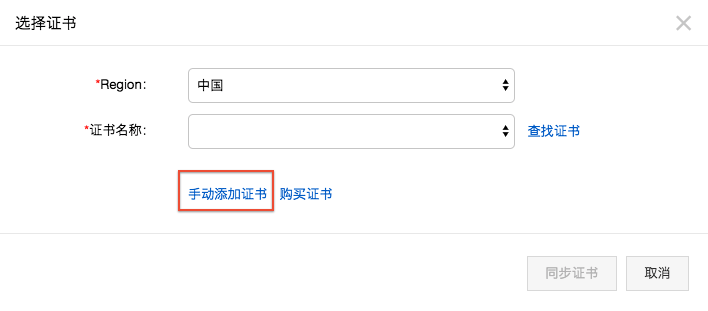
步骤3. 在手动添加证书页面,将第二章中说道的三个证书分别填写到本页面中:
-
服务器端公钥证书(server.crt)的内容填写到“证书内容”文本框中;
-
服务器端私钥文件(server.key)的内容填写到“私钥”文本框中;
-
根证书(root.crt)的内容填写到“根证书”的文本框中;
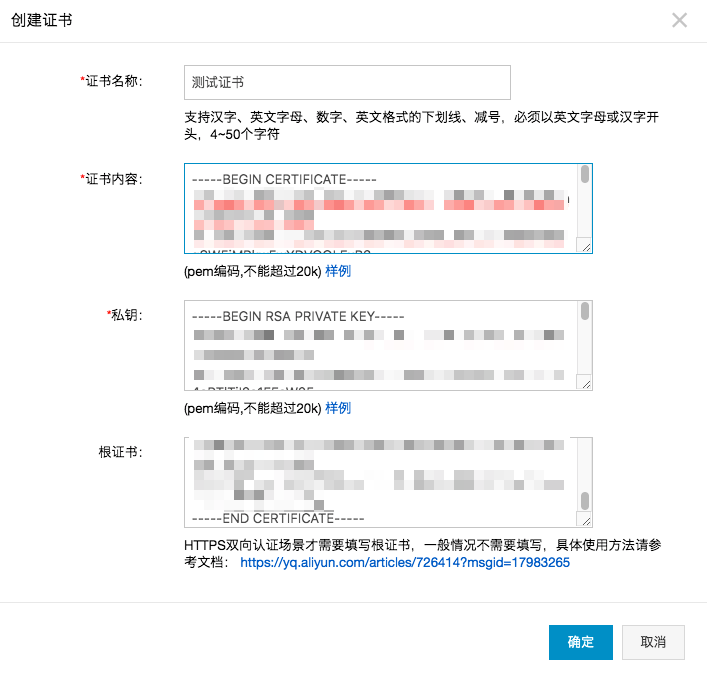
通过以上三个步骤就可以在API网关完成配置HTTPS双向认证的配置。
4. 自签名证书
生成这一些列证书之前,我们需要先生成一个CA根证书,然后由这个CA根证书颁发服务器公钥证书和客户端公钥证书。为了验证根证书颁发验证客户端证书这个逻辑,我们使用根证书生成两套不同的客户端证书,然后同时用两个客户端证书来发送请求,看服务器端是否都能识别。下面是证书生成的内在逻辑示意图:
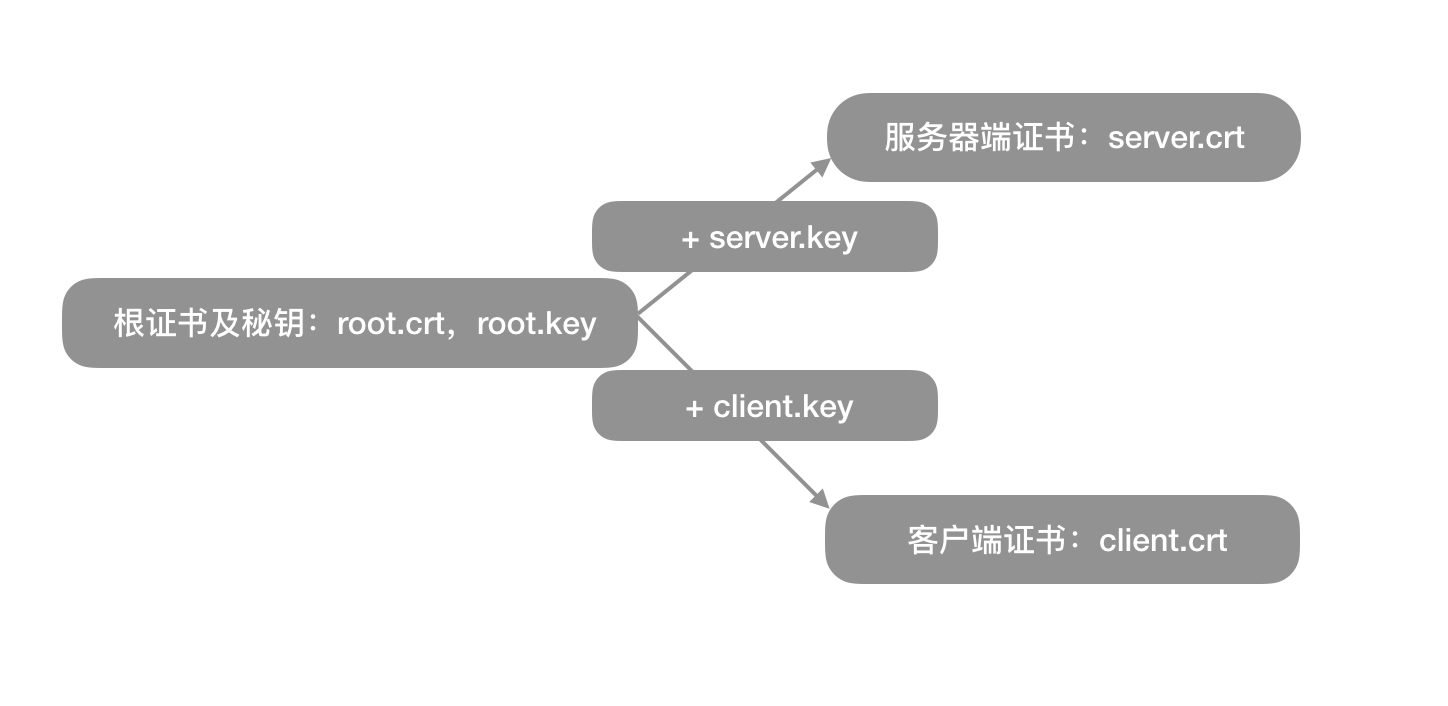
4.1生成自签名根证书
(1)创建根证书私钥:
openssl genrsa -out root.key 1024(2)创建根证书请求文件:
openssl req -new -out root.csr -key root.key后续参数请自行填写,下面是一个例子:
Country Name (2 letter code) [XX]:cn
State or Province Name (full name) []:bj
Locality Name (eg, city) [Default City]:bj
Organization Name (eg, company) [Default Company Ltd]:alibaba
Organizational Unit Name (eg, section) []:test
Common Name (eg, your name or your servers hostname) []:root
Email Address []:a.alibaba.com
A challenge password []:
An optional company name []:(3)创建根证书:
openssl x509 -req -in root.csr -out root.crt -signkey root.key -CAcreateserial -days 3650在创建证书请求文件的时候需要注意三点,下面生成服务器请求文件和客户端请求文件均要注意这三点: 根证书的Common Name填写root就可以,所有客户端和服务器端的证书这个字段需要填写域名,一定要注意的是,根证书的这个字段和客户端证书、服务器端证书不能一样; 其他所有字段的填写,根证书、服务器端证书、客户端证书需保持一致最后的密码可以直接回车跳过。
经过上面三个命令行,我们最终可以得到一个签名有效期为10年的根证书root.crt,后面我们可以用这个根证书去颁发服务器证书和客户端证书。
4.2 生成自签名服务器端证书
(1)生成服务器端证书私钥:
openssl genrsa -out server.key 1024(2) 生成服务器证书请求文件,过程和注意事项参考根证书,本节不详述:
openssl req -new -out server.csr -key server.key(3) 生成服务器端公钥证书
openssl x509 -req -in server.csr -out server.crt -signkey server.key -CA root.crt -CAkey root.key -CAcreateserial -days 3650经过上面的三个命令,我们得到:
server.key:服务器端的密钥文件 server.crt:有效期十年的服务器端公钥证书,使用根证书和服务器端私钥文件一起生成
4.3 生成自签名客户端证书
(1)生成客户端证书密钥:
openssl genrsa -out client.key 1024
openssl genrsa -out client2.key 1024(2) 生成客户端证书请求文件,过程和注意事项参考根证书,本节不详述:
openssl req -new -out client.csr -key client.key
openssl req -new -out client2.csr -key client2.key(3) 生客户端证书
openssl x509 -req -in client.csr -out client.crt -signkey client.key -CA root.crt -CAkey root.key -CAcreateserial -days 3650
openssl x509 -req -in client2.csr -out client2.crt -signkey client2.key -CA root.crt -CAkey root.key -CAcreateserial -days 3650(4) 生客户端p12格式证书,需要输入一个密码,选一个好记的,比如123456
openssl pkcs12 -export -clcerts -in client.crt -inkey client.key -out client.p12
openssl pkcs12 -export -clcerts -in client2.crt -inkey client2.key -out client2.p12重复使用上面的命令,我们得到两套客户端证书:
- client.key / client2.key:客户端的私钥文件
- client.crt / client2.key:有效期十年的客户端证书
使用根证书和客户端私钥一起生成 client.p12/client2.p12,这个证书文件包含客户端的公钥和私钥,主要用来给浏览器访问使用
5. 验证
使用curl加上证书路径,可以直接测试Nginx的HTTPS双向认证是否配置成功。下面我们测试三个用例:
-
使用client.crt / client.key这一套客户端证书来调用服务器端
-
使用client.crt2 / client2.key这一套客户端证书来调用服务器端
-
不使用证书来调用服务器端
下面是三个用例的测试结果:
5.1 带证书的成功调用
#--cert指定客户端公钥证书的路径
#--key指定客户端私钥文件的路径
#-k 使用本参数不校验证书的合法性,因为我们用的是自签名证书
#可以使用-v来观察具体的SSL握手过程
curl --cert ./client.crt --key ./client.key https://integration-fred2.fredhuang.com -k -v
* Rebuilt URL to: https://47.93.XX.XX/
* Trying 47.93.XX.XX...
* TCP_NODELAY set
* Connected to 47.93.XX.XX (47.93.XX.XX) port 443 (#0)
* ALPN, offering h2
* ALPN, offering http/1.1
* Cipher selection: ALL:!EXPORT:!EXPORT40:!EXPORT56:!aNULL:!LOW:!RC4:@STRENGTH
* successfully set certificate verify locations:
* CAfile: /etc/ssl/cert.pem
CApath: none
* TLSv1.2 (OUT), TLS handshake, Client hello (1):
* TLSv1.2 (IN), TLS handshake, Server hello (2):
* TLSv1.2 (IN), TLS handshake, Certificate (11):
* TLSv1.2 (IN), TLS handshake, Server key exchange (12):
* TLSv1.2 (IN), TLS handshake, Request CERT (13):
* TLSv1.2 (IN), TLS handshake, Server finished (14):
* TLSv1.2 (OUT), TLS handshake, Certificate (11):
* TLSv1.2 (OUT), TLS handshake, Client key exchange (16):
* TLSv1.2 (OUT), TLS handshake, CERT verify (15):
* TLSv1.2 (OUT), TLS change cipher, Client hello (1):
* TLSv1.2 (OUT), TLS handshake, Finished (20):
* TLSv1.2 (IN), TLS change cipher, Client hello (1):
* TLSv1.2 (IN), TLS handshake, Finished (20):
* SSL connection using TLSv1.2 / ECDHE-RSA-AES256-GCM-SHA384
* ALPN, server accepted to use http/1.1
* Server certificate:
* subject: C=CN; ST=BJ; L=BJ; O=Alibaba; OU=Test; CN=integration-fred2.fredhuang.com; [email protected]
* start date: Nov 2 01:01:34 2019 GMT
* expire date: Oct 30 01:01:34 2029 GMT
* issuer: C=CN; ST=BJ; L=BJ; O=Alibaba; OU=Test; CN=root; [email protected]
* SSL certificate verify result: unable to get local issuer certificate (20), continuing anyway.
> GET / HTTP/1.1
> host:integration-fred2.fredhuang.com
> User-Agent: curl/7.54.0
> Accept: */*
< HTTP/1.1 200 OK
< Server: nginx/1.17.5
< Date: Sat, 02 Nov 2019 02:39:43 GMT
< Content-Type: text/html
< Content-Length: 612
< Last-Modified: Wed, 30 Oct 2019 11:29:45 GMT
< Connection: keep-alive
< ETag: "5db97429-264"
< Accept-Ranges: bytes
<!DOCTYPE html>
<title>Welcome to nginx!</title>
<style>
body {
width: 35em;
margin: 0 auto;
font-family: Tahoma, Verdana, Arial, sans-serif;
</style>
</head>
<h1>Welcome to nginx!</h1>
<p>If you see this page, the nginx web server is successfully installed and
working. Further configuration is required.</p>
<p>For online documentation and support please refer to
<a href="http://nginx.org/">nginx.org</a>.<br/>
Commercial support is available at
<a href="http://nginx.com/">nginx.com</a>.</p>
<p><em>Thank you for using nginx.</em></p>
</body>
</html>
* Connection #0 to host 47.93.XX.XX left intact
使用client2.crt / client2.key这一套客户端证书来调用服务器端
curl --cert ./client2.crt --key ./client2.key https://integration-fred2.fredhuang.com -k
<!DOCTYPE html>
<title>Welcome to nginx!</title>
<style>
body {
width: 35em;
margin: 0 auto;
font-family: Tahoma, Verdana, Arial, sans-serif;
</style>
</head>
<h1>Welcome to nginx!</h1>
<p>If you see this page, the nginx web server is successfully installed and
working. Further configuration is required.</p>
<p>For online documentation and support please refer to
<a href="http://nginx.org/">nginx.org</a>.<br/>
Commercial support is available at
<a href="http://nginx.com/">nginx.com</a>.</p>
<p><em>Thank you for using nginx.</em></p>
</body>
</html>
5.2 不带证书的调用
curl https://integration-fred2.fredhuang.com -k
<head><title>400 No required SSL certificate was sent</title></head>
<center><h1>400 Bad Request</h1></center>
<center>No required SSL certificate was sent</center>
<hr><center>nginx/1.17.5</center>
</body>
</html>
三个用例都符合预期,从第一个测试日志中,我们可以看到,整个通信过程较长,客户端验证服务器端的证书,客户端也将自己的证书上传到服务器端进行验证。使用根证书颁发的两个客户端证书都可以正常发起双向HTTPS认证的调用。没有带客户端证书的调用会被服务器端拒绝服务。
6. 使用Java调用
由于使用的是自签名证书,使用ApacheHttpClient去调用的话,需要将服务器证书加入可信任证书库中,才能成功调用,也可以在代码中简单忽略证书。
cd $JAVA_HOME
sudo ./bin/keytool -import -alias ttt -keystore cacerts -file /Users/fred/temp/cert5/server.crt
将服务器端公钥证书设置为可信证书后,使用以下代码可以直接发起带客户端证书的HTTPS请求:
import org.apache.http.HttpEntity;
import org.apache.http.client.methods.CloseableHttpResponse;
import org.apache.http.client.methods.HttpGet;
import org.apache.http.conn.ssl.SSLConnectionSocketFactory;
import org.apache.http.impl.client.CloseableHttpClient;
import org.apache.http.impl.client.HttpClients;
import org.apache.http.ssl.SSLContexts;
import org.apache.http.util.EntityUtils;
import javax.net.ssl.SSLContext;
import java.io.File;
import java.io.FileInputStream;
import java.io.InputStream;
import java.security.KeyStore;
public class HttpClientWithClientCert {
private final static String PFX_PATH = "/Users/fred/temp/cert5/client.p12"; //客户端证书路径
private final static String PFX_PWD = "123456"; //客户端证书密码
public static String sslRequestGet(String url) throws Exception {
KeyStore keyStore = KeyStore.getInstance("PKCS12");
InputStream instream = new FileInputStream(new File(PFX_PATH));
try {
keyStore.load(instream, PFX_PWD.toCharArray());
} finally {
instream.close();
SSLContext sslcontext = SSLContexts.custom().loadKeyMaterial(keyStore, PFX_PWD.toCharArray()).build();
SSLConnectionSocketFactory sslsf = new SSLConnectionSocketFactory(sslcontext
, new String[] { "TLSv1" } // supportedProtocols ,这里可以按需要设置
, null // supportedCipherSuites
, SSLConnectionSocketFactory.getDefaultHostnameVerifier());
CloseableHttpClient httpclient = HttpClients.custom().setSSLSocketFactory(sslsf).build();
try {
HttpGet httpget = new HttpGet(url);
//httpget.addHeader("host", "integration-fred2.fredhuang.com");// 设置一些heander等
CloseableHttpResponse response = httpclient.execute(httpget);
try {
HttpEntity entity = response.getEntity();
String jsonStr = EntityUtils.toString(response.getEntity(), "UTF-8");//返回结果
EntityUtils.consume(entity);
return jsonStr;
} finally {
response.close();
} finally {
httpclient.close();
public static void main(String[] args) throws Exception {
System.out.println(System.getProperty("java.home"));
System.out.println(sslRequestGet("https://integration-fred2.fredhuang.com"));